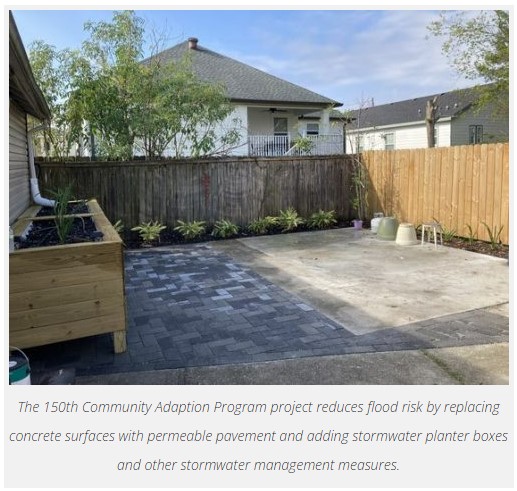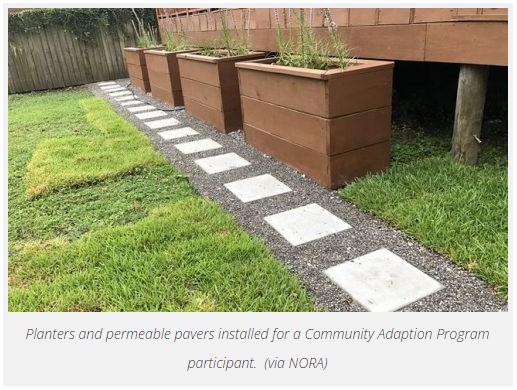Resilience Playbook in Gentilly Offers Model for Flood-Prone Cities
The Gentilly Resilience District is fortifying the hurricane-battered New Orleans neighborhood against natural disaster
BY ANNA STAROPOLI JUNE 7, 2023 8:00 AM
The New Orleans residential neighborhood of Gentilly, on the south shore of Lake Pontchartrain, is bracketed by water on three sides, with bayous and canals snaking along the neighborhood’s edges.
Because of its proximity to the water, the low-lying region of the city was swallowed by Hurricane Katrina in 2005. Stories abound of the neighborhood being under water for months after the initial storm, of frantic residents escaping to higher ground, and not coming back for years, if ever.
And yet, 18 years after one of the deadliest storms in U.S. history, Gentilly is actually well positioned to withstand further damage, even as it confronts rising sea levels and stronger storms. That’s thanks to the city’s aggressive resilience measures, which may serve as a model for other cities around the world.
Gentilly’s approach has been multi-pronged, focusing on both top-down infrastructure programs, as well as more on-the-ground perspectives, funded by a variety of federal and local programs. Crucially, in addition to public infrastructure, Gentilly has enlisted residents in the fight for adaptation. Gentilly owners have transformed their low-lying yards into rain gardens designed to collect stormwater, and repaved driveways and patios with material that absorbs runoff, creating a landscape naturally prepared for intermittent flooding.
These adaptations were made possible by the Gentilly Resilience District, a City of New Orleans initiative to build, pay and advocate for homeowner resilience, in partnership with the New Orleans Redevelopment Authority (NORA), which manages city-owned property.
In fact, much of NORA’s property inventory resulted from the surge in voluntary buyouts by the federal government following Katrina, said Seth Knudsen, NORA’s chief of strategy, programs and projects. These buyouts paved the way for NORA’s investments in the area, while also contextualizing the resolution of the residents that remained.
But while the Gentilly Resilience District program is unique, Gentilly itself is fairly representative of New Orleans on the whole in terms of its potential, its challenges and the racial and socio-economic makeup of the population, said Knudsen.
As a low- to moderate-income neighborhood, Gentilly homeowners typically can’t afford resilient investments on their own. Increasing a property’s water storage capacity, for example, to withstand just the first inch of rainwater typically costs up to $25,0000, said Knudsen. Under the resilience district program, homeowners can instead apply for aid, which NORA provides on a rolling basis. As of April 2023, the agency had assisted 193 homes with adaptive projects.
Similar resilience districts and city-specific organizations have cropped up across the world. Copenhagen boasts a climate-resilient neighborhood strategy while San Francisco has its own resiliency plans. Closer to New Orleans, Southeast Florida has discussed elevating Route 1, which connects mainland Florida with the Florida Keys, so that residents can evacuate during storms.
The distinction is that instead of focusing on climate change as a purely environmental problem, with environmental solutions, these resilience programs tend to focus on the people who inhabit cities and will therefore bear the consequences of climate change. Gentilly, as the city’s first resilience district, serves as a model to the remainder of New Orleans—and to other cities across the world more broadly—about how to harness new and existing government programs to leverage community engagement and prepare for the future. Efforts in Gentilly have gone above and beyond building codes and planning bureaucracies to set the bar for how cities can put resilience at the forefront of neighborhood infrastructure.
“Nobody’s really, I think, willing to say, ‘Ah that’s it, it’s time to pack our bags and go,’ ” Brittany Ryan, director of responsible investing at Nuveen, told Commercial Observer in April. “It’s more, ‘What can we invest in the communities that we love so much to enhance their resilience and adapt them so we can live here and future generations can live here under a new, climate change[d] world?’ ”
Perhaps nowhere better reflects such passion for place than New Orleans, a city whose resilience has been tested not just by Hurricane Katrina but also by 2012’s Hurricane Isaac, both of which left an indelible mark. In the decade since, climate change has only upped the city’s risks, with both sea levels and storm intensity on the rise. New Orleans’ proximity to the Gulf of Mexico, as well as various tributaries, define both the city’s geography and potential for disaster.
“Louisiana can expect to see Gulf waters rise by two to seven feet over the next century, the highest rate in the U.S. and among the highest on Earth,” reads the wall text for the Hurricane Katrina exhibit at the Louisiana State Presbytère Museum.
That museum, built in a house battered by Katrina, epitomizes the ways in which New Orleans cities and their interconnected communities are here for the long haul. And everybody, in every New Orleans neighborhood, shares the challenges from storms and sea level rise, said NORA’s Knudsen.
NORA calls for the same property standards across New Orleans to protect homes from flooding, reduce stormwater runoff and meet energy efficiency standards. Currently, NORA’s residential buildings and new construction developments must fulfill certain storm protection according to a program called FORTIFIED, which sets home protection standards beyond building codes—making it the country’s first agency to do so.
NORA also requires its buildings to meet energy efficiency standards under the Energy Star three rubric, and to store at least 1,000 gallons of stormwater on-site so that in an event of extreme rain, NORA-funded properties will be better equipped to both reduce and endure severe flooding.
Neighborhoods differ in the type and level of protective investments, in order to match its vulnerabilities. “Resilience isn’t contingent upon the neighborhood and where you are,” said Brenda Breaux, executive director at NORA. “It’s the type of intervention that you might place in one particular neighborhood that may not be the same that you would place in another.”
Gentilly has been at the forefront of resilience efforts partially due to the level of funding it received following the damage it endured in Katrina. Levees failed in more than 50 locations during the hurricane, unleashing Lake Pontchartrain waters, which surged into Gentilly, as well as other low-lying neighborhoods like Treme, Baywater and the Ninth Ward.
It wasn’t until after Hurricane Isaac, however, that the City of New Orleans applied for the National Disaster Resilience, which was granted in 2016, providing $141 million in funding from the U.S. Department of Housing and Urban Development (HUD) to put towards resilience endeavors.
The funding gave birth to the Gentilly Resilience District for Gentilly in particular, which was eligible for funding because of the flooding it had sustained, explained Breaux. New Orleans also allocated roughly $20 million of HUD funding to NORA, which implemented the previously-mentioned program focused on homeowners and their individual properties, officially called the Community Adaptation Program (CAP).
That’s how those permeable paver driveways and rain gardens came to exist, improving the neighborhood’s ability to deal with rainfall and flooding. “Through the Community Adaptation Program, we’ve been able to achieve storage capacity of the first inch-plus of rain at each of these home sites,” said Knudsen.
NORA likewise allocates other federal grants — even those that don’t specifically require resilience investments — toward corresponding upgrades, said Knudsen. These funds may include the Community Development Block Grant (CDBG) Entitlement Program or CDBG Disaster Recovery funds, both of which go through HUD.
In addition to Gentilly’s environmental history, its topography stands out, said Knudsen. Varying elevation across the city has created an uneven playing field — both literally and metaphorically — through ranging climatic risks and allocated resources. Higher-elevated neighborhoods are located along the lake and riverfront, whereas neighborhoods like Broadmore and the northern half of the Lower Ninth Ward are closer to sea level.
Sections of Gentilly fall into both categories. “[Gentilly] has the sort of full topography of the city within it,” said Knudsen. “There’s high ground, there’s low ground and it’s its own drainage basin. And so it makes a lot of sense to focus stormwater runoff and mitigation efforts within that drainage basin from a comprehensive approach.”
That’s why the resiliency district also incorporates the neighborhood’s natural environment, while looking to revitalize larger neighborhood spaces and surroundings, City-owned, undeveloped parcels of land in Gentilly — like golf courses and wetlands — have created opportunities for those larger-scale water mitigation projects. “Wetlands are good carbon sinks,” Hyon Rah, former director of ESG consultancy at Savills, told Commercial Observer in April, “but also they work as a buffer against storm surges and other extreme weathers.”
One such project is the retrofitting of the Dillard Wetlands, a plan to utilize 27 acres of woodlands with the triple goal of stormwater management, increase biodiversity and creating a usable community green space with educational, recreational and social opportunities—a perfect encapsulation of the holistic efforts exemplified by the resilience district.
These public opportunities also highlight the importance of partnerships in resilience efforts, whether that’s between neighborhoods and organizations, like Gentilly and NORA, or between the public and private sectors. “We can’t maximize our potential and reduce stormwater runoff and the negative effects that go with it if the public sector is still expected to manage all of the water that falls within the city,” said Knudsen, noting that the bulk of the responsibility still falls on the public sector.
Back at the Louisiana State Presbytère Museum, an interactive exhibit highlights both the importance of wetlands and the ways in which rising sea levels are inhibiting them. Erosion has jeopardized Louisiana’s marshes and their protective properties.
So, resilience efforts in Gentilly are twofold: They’re not only preparing houses for climate change, but also helping the environment adapt to climate change’s impact. These ventures run parallel and happen contemporaneously, said Breaux. “Every neighborhood is a puzzle,” said Knudsen.
In Gentilly, yet another puzzle piece has clicked into place. While the resilience district focuses on the built and natural environment, other endeavors indirectly fuel the softer, less tangible characteristics of a resilient community. Take those rain gardens, for example. They not only address rainwater, they can also enhance property values by providing green space, or offer a place for community members to sit and study or simply enjoy a cup of coffee, said Knudson.
These softer facets that create community — along with social networks, families, churches, neighborhood associations and individual family resilience — contribute to a neighborhood’s resilience, said Knudsen. They don’t explicitly relate to what his organization deals with in day-to-day operations, but they’re implicitly part of the built environment.
Gentilly’s residents are “the ones that need to be built up,” said Breaux.
And at the end of the day, they’re the largest stakeholders, and the ones left holding the bag, Breaux added. “Five years out, 10 years out, it’s going to be those citizens. ”
As for what the resilience district indicates for Gentilly’s future, people have to see the impact of the investments to believe them. Much of real estate innovation happens behind the scenes in design, engineering and construction — phases that aren’t typically in the public eye, said Knudsen.
But for the residents of Gentilly, they can see the results. When it rains, water now flows to where it’s directed, because of the city’s investment in stormwater management on residential lots and around the drainage canal. “The proof for them is there,” said Knudsen. “The people that have lived there for a long time know that it’s different now.”
Anna Staropoli can be reached at This email address is being protected from spambots. You need JavaScript enabled to view it..





